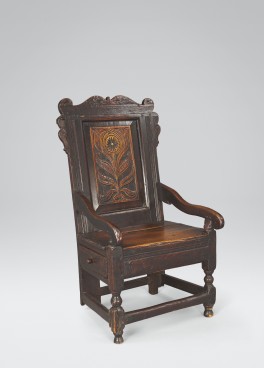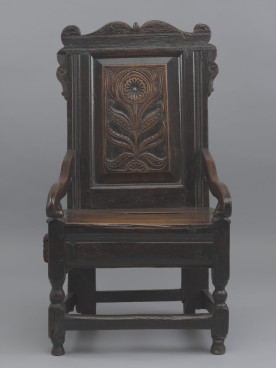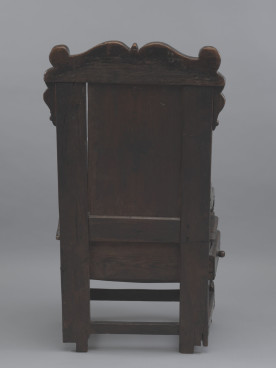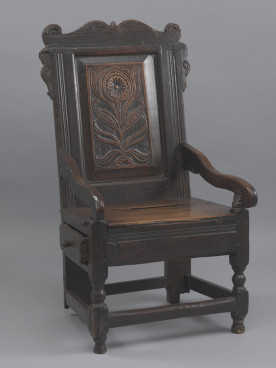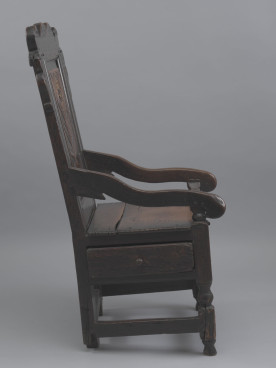Armchair, c.1680
Oak and chestnut
This is an unusually low chair, with low arms and a drawer to one side beneath the seat, and may have been used for needlework. Chairs of this type are sometimes called nursing chairs.
Adam Bowett Catalogue (12/05/2013)
Description
A joined arm chair, circa 1680. The fielded panel back is carved with a flower and foliage beneath a shaped crest rail with scrolled brackets; the down-curved arms are set very low and supported on short turned stubs extending from the tops of the front legs; the seat is boarded and there is a drawer underneath to the left side. The fore legs are baluster-turned, with turned feet, and joined by plain stretchers all round.
Dimensions
H: 36 ½ ” (93cm) Seat height: 15 ” (38 cm) W: 21 ½ ” ( 54 cm) D: 21 ” (54cm)
Materials
Oak and chestnut
Dating Criteria
Joined panel back chairs were made over a very long period, but the fielded panel (as distinct from flat panel) back suggests a late 17th century date.
Construction
The chair is of joined construction with pegged mortise and tenon joints throughout. The back panel is a single board of chestnut, housed in rebate in all sides of the back frame. The top rail is mortised onto the back posts and the scrolled brackets to each side are rebated into the underside of the top rail and pegged through to the side of the back posts. The arms are tenoned into the back posts and double pegged; they are mortised and double-pegged onto the extensions of the front legs rising above the seat. The seat is of two boards running side to side, butt jointed and originally pegged to the seat rails. The deep seat rails are double pegged into the front and back legs all round except on the left side where there are two thinner rails framing the drawer aperture. The drawer is supported on two thin laths running side to side and nailed to front and back legs respectively. The chestnut back seat rail (which is normally absent on panel-back chairs but is here necessary to conceal the drawer) fitted into the back legs with very large dovetails, now nailed in place. The drawer has an oak front and chestnut bottom, sides and back; all elements are nailed. The back, side and front joints are slightly rebated, the bottom is planted up and nailed except on the left side where it is butted against lower side of the drawer which is deeper on this side. Stretchers are double pegged all round.
Marks or Stamps
none
Condition
the back appears to be largely original; left side ear piece replaced. Shrinkage to back board had produced a gap top right, with associated split to moulding on frame. Arms heavily worn but apparently with original pegging. Seat rails and stretchers ditto. Splits the lower parts of both legs; turned feet are replaced. Right stretcher has split along its length, apparently caused by insertion of nails for reasons unknown. There is considerable damage to both rear feet and both are notched to receive a batten which presumably ran forward to the front legs to stabilise the chair before the present front feet were added. The seat has a serious split towards the back and several other minor splits; it has been nailed and screwed repeatedly to the seat rails. The back drawer runner is possibly original, the front is replaced.
Additional Remarks
Low chairs with low-set arms are often called ‘nursing’ chairs, the idea being that the low arms allow a mother to nurse her baby. However, 19th century photographs from the north of England show chairs with low arms being used for knitting; this was an important part of the rural economy in parts of northern England. The shape of the cresting and scrolled brackets is consistent with a northern English provenance; moreover, chairs with drawers in the seats (so-called ‘lambing’ chairs) are relatively common in Lancashire and Yorkshire, although most examples are 18th century and later.
References
Illustrated in Tobias Jellinek, Early British Chairs and Seats 1500-1700, Woodbridge (2009), p. 75, pl. 59.
Provenance
Sandy and Stuart Moss Collection 2009.

